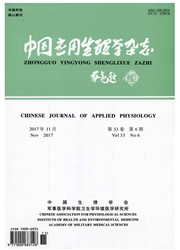

 中文摘要:
中文摘要:
目的:研究棕榈酸(PA)诱导肝细胞损伤的体外模拟非酒精性脂肪肝(NAFLD)模型中线粒体发动相关蛋白1(Drp1)和融合蛋白2(Mfn2)的作用机制以及姜黄素衍生物L6H4的保护作用。方法:1分别以不同浓度的PA、油酸(OA)和PA+姜黄素衍生物L6H4的混合培养基培养大鼠BRL-3A正常肝细胞24 h。用MTT法检测细胞活力,以筛选制作体外模拟NAFLD模型的最佳PA浓度及姜黄素衍生物L6H4的干预浓度。2将细胞分为4组:对照组(CON组)、油酸组(OA组)、棕榈酸组(PA组)及姜黄素衍生物L6H4干预组(L6H4组),分别给予正常培养基、含有OA的培养基、含有PA的培养基及含有PA和姜黄素衍生物L6H4的混合培养基进行干预,24 h后收获细胞。分别用羟胺法测定总超氧化物歧化酶(T-SOD)含量、硫代巴比妥酸法测定丙二醛(MDA)含量、Real-time PCR及Western Blot法检测肝细胞Drp1、Mfn2、Bcl-2、Bax、Caspase-3、TNF-αm RNA及蛋白的表达。结果:1不同浓度PA对BRL-3A细胞的生长均具有一定的抑制作用,差异具有统计学意义(P〈0.05),并呈明显剂量依赖关系,0.1 mmol/L是分界点,而0.05 mmol/L OA对细胞活力无明显影响。因此选择0.05 mmol/L PA作为最佳造模浓度以建立NAFLD体外模型。2当姜黄素衍生物L6H4干预浓度≤10μmol/L时,细胞活力均高于75%,浓度〉20μmol/L时,细胞活力降至50%以下,差异具有统计学意义(P〈0.05)。10μmol/L时是分界点,因此选择5μmol/L作为后续L6H4干预浓度。3与CON组相比,PA组细胞MDA含量、Drp1、Bax、Caspase-3、TNF-α的m RNA及蛋白的表达均显著增加,差异均具有统计学意义(P〈0.05);而T-SOD活力、Mfn2、Bcl-2的m RNA及蛋白表达则显著下降,差异均具有统计学意义(P〈0.05);与PA组相比,L6H4组的MDA含量、Drp1、Bax、Caspase-3、TNF-α的m RNA及蛋白的表达均显著降低,差异均具有统计学意义(P〈0.05),T-SOD活力、Bcl-2 m RNA
 英文摘要:
英文摘要:
Objective: To explore the roles and mechanism of mitochondrial dynamin-related protein 1 (drpl) and mitochondrial fusion protein 2 (Mfn2) in palmitate (PA) induced rat hepatocyte injury in the model of nonalcoholic-fatty-liver-disease (NAFLD) in vitro, and the effects of curcumin derivative L6H4 on it. Methods: Rat BRL-3A hepatocytes were cultured with difference concentrations of PA and oleate (OA) and PA+ curcumin derivative L6H4 mixed medium for 24 hours respectively. Cell vitality was detected by MTT assay and the opti- mal concentration of PA for establishing non alcoholic fatty liver model in vitro and drug intervention ofcurcum- in derivative L6H4 were screened. Cells were divided into 4 groups: control group (CON group), oleate group (OA group), palmitate group (PA group) and curcumin derivative L6H4 intervention group (L6H4 group), and were cultured with normal medium, containing oleate medium, containing palmitate medium and containing pal- mitate and curcumin derivative L6H4 mixed medium for 24 hours, respectively. Total SOD activity was detected by hydroxylamine method. The content of MDA was analyzsed by thiobarbituric acid method. The expression of mRNA and protein of Drp 1, Mfn2, Bcl-2, Bax, Caspase-3, TNF-α of hepatocyte were detected by real-time PCR and Western blot respectively. Results: Different concentrations of PA had certain inhibitory effect on BRL-3A cells growth (P〈0.05), and showed a clear dose dependence manner, 0.1 mmol/L PA was the cut-offpoint, while 0.05 mmol/L OA had no obvious effect. 0.05 mmol/L PA was selected as the optimal concentration to establish the model of NAFLD in vitro. The cell viability was higher than 75% when the concentration of curcumin deriva- tive L6H4 was lower than 10 gmol/L. The cell viability dropped to below 50% (P〈0.05) when the concentration of curcumin derivatives L6H4 was higher than 20 ~tmol/L, 10 ~tmol/L L6H4 was the cut-off point. Therefore, 5 ~tmol/L curcumin derivative L6H4 was chosen fo
 同期刊论文项目
同期刊论文项目
 同项目期刊论文
同项目期刊论文
 期刊信息
期刊信息
